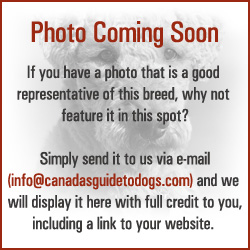
Sealyham Terrier
Group: Terrier
Origin: Great Britain
Height: 10.5 inches (27 cm)
Weight: 23 to 24 lbs (10-11 kg)

CLICK HERE to View Breeder Listings
Breed Profile
The Sealyham originates from Wales and was developed to be the ultimate working Terrier — fast and fearless as a hunter, and tough and agile enough to slip down a badger hole. It is believed that the Sealyham was developed from a combination of the Pembroke Welsh Corgi for his size, the Cheshire Terrier for his gameness and colour, the Dandie Dinmont Terrier for his courage, the Wire Fox Terrier for his coat type, and the West Highland White Terrier to reduce his size and strengthen the colour. Both the American Kennel Club and the Kennel Club (U.K.) officially recognized the breed in 1911.
The Sealyham is an outgoing and friendly dog, yet a good watchdog who is devoted and loyal to his family. He has a “big-dog” bark, is keen, alert, determined, and has all the true Terrier characteristics. He does, however, generally have a calm and relaxed disposition. He is known to be very good with children due to his playful attitude and ougoing personality. Because the Sealyham was bred to work in packs, he also usually gets along well with other dogs of roughly the same size.
His outercoat is hard and wiry with a soft, dense undercoat. His colouring is all white and he may have lemon, tan, or badger markings on the head and ears.
Health Issues
If you are considering the adoption of a Sealyham Terrier puppy, or any breed, it is very important to be selective in choosing a responsible and reputable breeder. Ensure that the prospective puppy’s parents have all health clearances. Breeding of any dog should not be done until after they have been proven to be free of evidence of significant hereditary diseases.
Additional Health Resources:
- Health and Nutrition — Growing section of the Canada’s Guide to Dogs website which includes information on several health and nutrition related issues.
- Canine Health Information Center (CHIC) — Providing a source of health information for owners, breeders, and scientists that will assist in breeding healthy dogs. CHIC is a centralized canine health database jointly sponsored by the AKC/Canine Health Foundation (AKC/CHF) and the Orthopedic Foundation for Animals (OFA).
- AKC Canine Health Foundation — Working towards developing scientific advances in canine health.
- Canine Eye Registration Foundation (CERF)
- Orthopedic Foundation for Animals (OFA)
- Ontario Veterinary College (OVC)
- University of Pennsylvania Hip Improvement Program (PennHip)
- HealthGene — HealthGene Corporation is the leading provider of veterinary DNA diagnostic services in Canada.
- Labgenvet — Laboratory of Veterinary Genetics is a Canadian diagnostic laboratory that offers a comprehensive service of DNA tests for veterinary genetic diseases.
Grooming Information
The Sealyham’s double coat requires regular maintenance. The “show coat” is regularly hand stripped with the long and dead hairs plucked out by hand. A “pet coat” can be clipped on the head and topcoat, and scissoring on the legs and face. Regular brushing is required to keep the coat tangle and mat free.
- Grooming — This section of the Canada’s Guide to Dogs website includes tips, articles and information covering all aspects of dog grooming along with a listing of Groomers from across Canada.
Training Resources
- Training — For training information, see this growing section of the Canada’s Guide to Dogs website for tips, articles, as well as listings of training centres across Canada.
Additional Information
- Clubs, Sports & Activities — For information on the many sports and activities you can get involved in with your dog.
- Working Dogs — The Working Dogs section of the Canada’s Guide to Dogs website provides information and listings of organizations that are involved in various dog jobs, such as Guide Dogs, Therapy Dogs, Police Dogs, Protection Dogs, and much more.
Breed Listing
*NOTE 1: CHIC – The Canine Health Information Center “is a database of consolidated health screening results from multiple sources. Co-sponsored by the Orthopedic Foundation for Animals (OFA) and the American Kennel Club (AKC) Canine Health Foundation, CHIC works with parent clubs to identify health screening protocols appropriate for individual breeds. Dogs tested in accordance with the parent club established requirements, that have their results registered and made available in the public domain are issued CHIC numbers.” To learn more, visit: www.caninehealthinfo.org
*NOTE 2: The Fédération Cynologique International (FCI) is the World Canine Organization, which includes 91 members and contract partners (one member per country) that each issue their own pedigrees and train their own judges. The FCI recognizes 344 breeds, with each being the “property” of a specific country. The “owner” countries write the standards of these breeds in co-operation with the Standards and Scientific Commissions of the FCI, and the translation and updating are carried out by the FCI. The FCI is not a breed registry nor does it issue pedigrees.
Quick Links
Get In Touch
- Email: canadasguidetodogs@gmail.com
- Email: info@canadasguidetodogs.com
- Visit us on Facebook: www.facebook.com/CanadasGuideToDogs
— CanadasGuideToDogs.com is an Amazon Associate as well as a participant in various affiliate programs, as such fees are earned from qualifying purchases.
